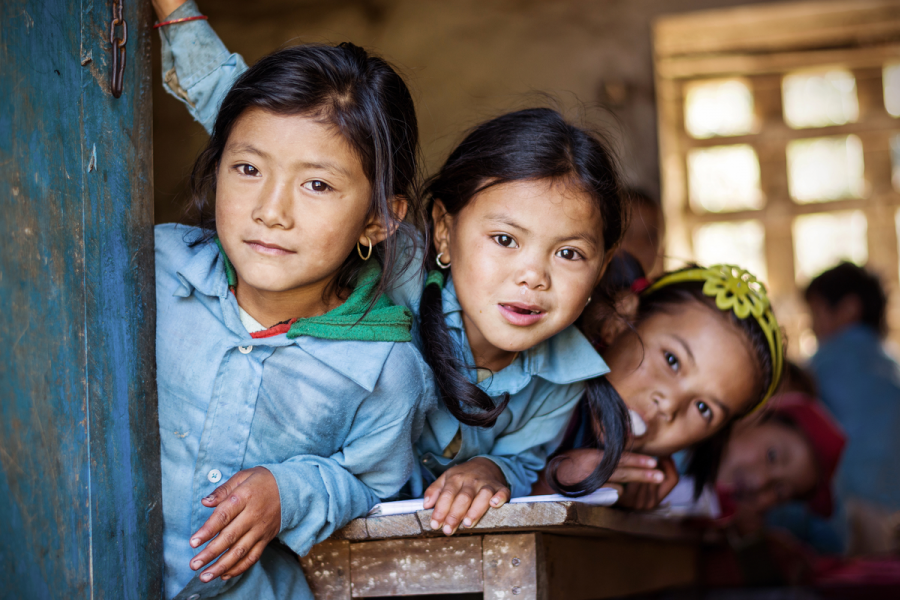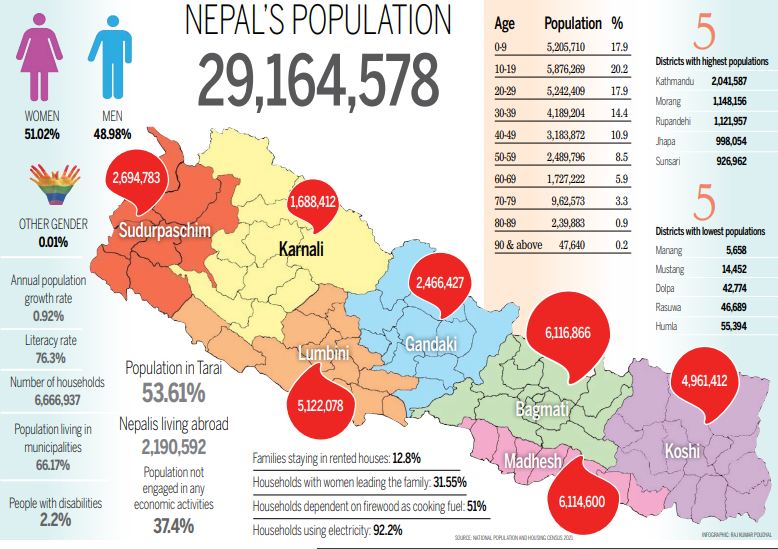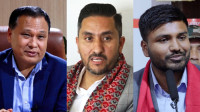National
Nepal is ageing as children’s share in population shrinks
Final census report does not break down population based on ethnicity, language, religion.
Prithvi Man Shrestha
Nepal saw a significant drop in the share of population aged 14 years or below while the share of people aged 15 years or above rose significantly during the period from 2011 and 2021, indicating that the country’s population is ageing.
According to the final data of the Population Census 2021 made public on Friday, the country’s total population stood at 29,164,578. Of the total, the share of children aged 14 years or below was 27.83 percent, a marked drop from 34.91 percent in the 2011 census.
When it comes to the share of the working age population in the 15-59 years age group, it grew to 61.96 percent in 2021 from 56.96 percent in 2011. The share of the population aged 60 years or above stood at 10.21 percent, a rise from 8.13 percent in 2011, according to the new census report.
People have started having fewer babies. According to the census report, annualised population growth from 2011 to 2021 stood at 0.92 percent, an 80-year low since Nepal started holding population census in 1911.
Nepal’s annual population growth rate now is less than the global average of 1.01 percent in 2020, according to the World Bank statistics.
“Fall in the population of children, who are dependent on their parents, and the rise in the working-age population is good for the country as it suggests the country has entered the phase where it can enjoy demographic dividend,” said Nebin Lal Shrestha, deputy chief statistical officer at the National Statistics Office. “But Nepal is deprived of this demographic advantage as youths are migrating to foreign lands in search of jobs for the lack of economic opportunities in the country.”
Officials and experts, however, are also worried that a reduction in the population of children and rise in elderly population could contribute to a slump in economic activities in the long term.
“Policymakers need to factor in a larger share of the ageing population in the future considering the current trend of low birth and high life expectancy,” said Hem Raj Regmi, another deputy chief statistical officer during the unveiling of the census report.

Various factors including outmigration of Nepali youths, rising cost of child-rearing, greater participation of women in workforce, and a delayed age for marriage, have collectively led to a decrease in the fertility rate, according to officials and experts.
On the other hand, with the nuclear family model growing popular and paucity of caregivers, people are having fewer babies, they said.
“The implication is that the high number of economically active population who will age over time will not be adequately replaced,” said Govinda Nepal, former member of the National Planning Commission. “The number of people who rely on others for support will grow.”
According to Nepal, there is nothing to be worried about the ageing population as the country’s working-age population has also been growing. “But it is necessary to analyse the pattern of ageing and introduce a policy on handling the future growth in the elderly population,” he added.
The state’s liability for social security of the elderly population along with other beneficiaries has been rising. The Sher Bahadur Deuba-led government reduced the eligibility age for elderly allowance to 68 years from 70 years from the current fiscal year 2022-23, putting a considerable financial burden on the state treasury.
According to the population census, there are 1.52 million people aged 68 years or above. The number of people of this age group was 999,417 as per the 2011 census.
Prime Minister Pushpa Kamal Dahal, who unveiled the final report of the census on Friday, also admitted that there has been an imbalance in the rate of population growth between younger and older age groups. “The census data will help bring special programmes aimed at population management,” he said.
The population census is crucial for devising policies and strategies for the next decade. “It will be key to budgeting and service delivery as per the development needs and diverse areas and make targeted investments,” said Won Young Hong, Country Representative of United Nations Population Fund.
Even though the report came up with detailed census data, the national statistics agency is yet to unveil population breakdowns, based on ethnicity, language and religion.
“As various institutions and individuals representing different ethnicities, languages and religions had diverse opinions on the categorization of population in certain sub-groups, we decided to wait for consensus on the matter,” said Shrestha, of the National Statistics Office.
He said that his office was holding consultations with various ethnicity and language related constitutional bodies but no consensus has been reached. “We hope to reach a certain consensus in the next four months after which we will produce population data based on ethnicity, language and religion,” he added
The erstwhile Central Bureau of Statistics, which has now been renamed as the National Statistics Office, had conducted a census from November 11 to November 25 in 2021.
Though the Central Bureau of Statistics had unveiled a preliminary census report in January last year, it took more than a year for the National Statistics Office to produce the final report.
“Initially, it was delayed by elections,” said an official of the National Statistics Office. “We had planned to unveil the final report in January, but that could not happen as the Election Commission barred us from doing so ahead of the presidential election.”
According to officials of the national data agency, the final census report does not include the population of Kalapani, Lipulekh and Limpiyadhura areas even though their population was included in the preliminary report made public last year.
“We could not reach these regions for census-taking owing to non-cooperation from the Indian authorities,” said Shrestha. “We have assessed that the total number of people in these regions is under 500. But we didn’t include the population of this region in the final report as verification was difficult.”
This story has been updated for clarity.




 16.2°C Kathmandu
16.2°C Kathmandu







%20(1).jpg&w=300&height=200)






